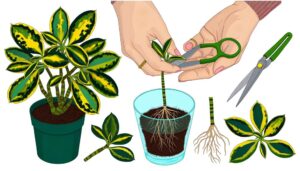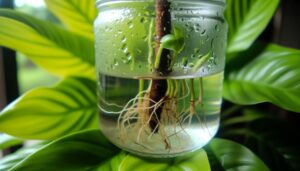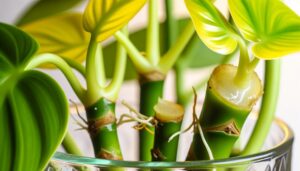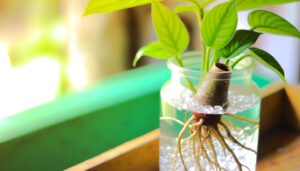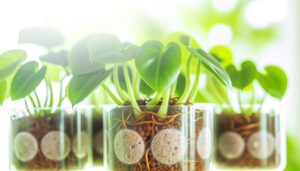How to Propagate Dark Lord Philodendron? A Complete Guide!
To propagate a Dark Lord Philodendron, select a healthy parent plant and use sharp, sterilized pruning shears to take a stem cutting. Guarantee your cutting has at least one node and is 4-6 inches long.
Remove leaves near the node and optionally use rooting hormone. Place the cutting in water or a well-draining potting mix made of perlite, peat moss, and orchid bark.
Maintain high humidity, indirect light, and consistent moisture. Monitor root development, changing water regularly if rooting in water.
Successful propagation hinges on specific environmental conditions and detailed monitoring of root health. More detailed guidance helps ensure success.
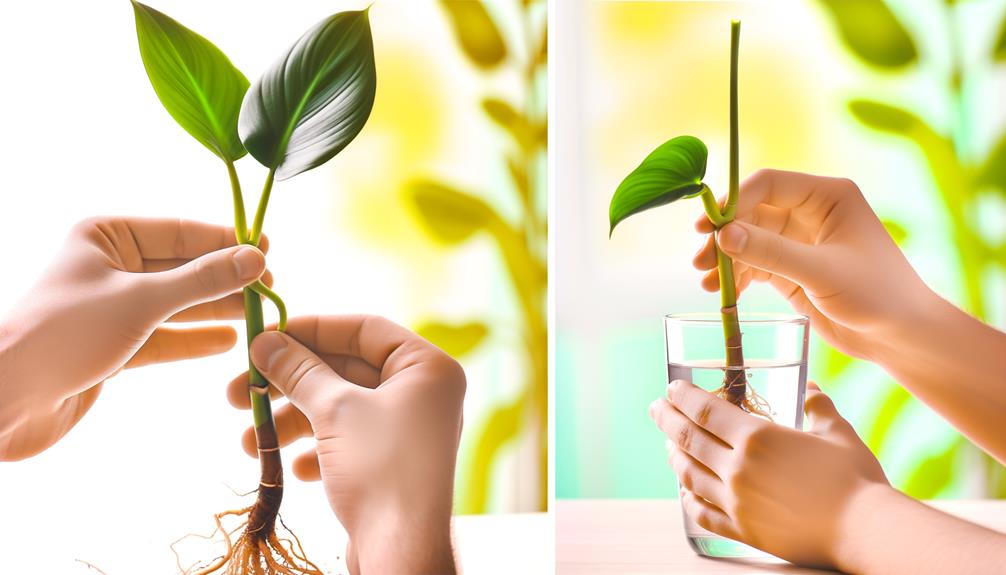
Key Takeaways
- Take stem cuttings with at least one node from a healthy Dark Lord Philodendron plant.
- Use sharp, sterilized pruning shears to make a 45-degree cut below the node.
- Place the cutting in water or well-draining soil mix to encourage root development.
- Maintain high humidity and indirect light for optimal growth conditions.
- Regularly monitor for healthy root growth and replace water every 5-7 days if rooting in water.
Understanding Philodendron Propagation
Understanding the spread of the Dark Lord Philodendron requires a thorough grasp of both its botanical characteristics and the specific conditions that promote successful growth. This Philodendron species, known for its striking dark foliage, typically propagates through stem cuttings.
Key to successful propagation is the identification of a healthy parent plant with robust, disease-free stems. Cuttings should include at least one node, as this is where roots will develop. Best growth conditions include maintaining a humid environment and ensuring indirect light exposure.
The use of a well-draining potting mix, enriched with organic matter, is vital. Additionally, maintaining consistent moisture levels without waterlogging is essential for root development. Monitoring these factors closely enhances the chances of successful propagation.
Choosing the Right Time
Timing is a critical factor in the successful propagation of Dark Lord Philodendron, with ideal periods aligning with the plant’s active growth phases. The best time to propagate is during the spring and summer months when the plant is vigorously growing. During these periods, the plant’s metabolic activities are at their peak, facilitating faster root development and overall growth.
This table provides an overview of the seasonal timing:
| Season | Propagation Viability |
|---|---|
| Spring | High |
| Summer | High |
| Fall | Moderate |
| Winter | Low |
Gathering Necessary Tools
To guarantee successful propagation of the Dark Lord Philodendron, it is crucial to gather necessary tools such as sharp pruning shears and a clean cutting board.
Equally important is the sterilization of all equipment to prevent contamination, which can be achieved using isopropyl alcohol or a similar disinfectant.
Essential Cutting Tools
Selecting the appropriate cutting tools is essential for ensuring clean cuts and promoting successful propagation of the Dark Lord Philodendron. High-quality, precise instruments facilitate the process and reduce plant stress.
The following tools are recommended:
- Pruning Shears: Ideal for making precise cuts on thicker stems.
- Sharp Knife: Useful for cleanly slicing through thinner stems and leaves.
- Scalpel: Provides high precision, especially beneficial for delicate or intricate cuts.
- Gardening Scissors: Suitable for trimming smaller leaves and stems with ease.
Each tool serves a specific function, ensuring that propagation procedures are efficient and effective. By utilizing these specialized instruments, one can minimize tissue damage, thereby enhancing the likelihood of robust root development and overall plant health.
Sterilizing Equipment
Ensuring the sterilization of cutting tools is a critical step in preventing disease transmission and promoting healthy propagation of the Dark Lord Philodendron.
Employing proper sterilization techniques minimizes the risk of introducing pathogens that could compromise plant health. Essential tools and substances for sterilization include isopropyl alcohol, bleach solutions, and flame sterilization methods.
| Tool | Method | Duration/Instructions |
|---|---|---|
| Pruning Shears | Isopropyl Alcohol (70%) | Soak for 5 minutes |
| Scalpels | Bleach Solution (10%) | Soak for 10 minutes |
| Cutting Blades | Flame Sterilization | Heat until red-hot, cool |
| Spray Bottles | Isopropyl Alcohol (70%) | Spray and air-dry |
Potting Medium Selection
Having confirmed the sterilization of all necessary equipment, the next step involves carefully selecting an appropriate potting medium to enhance the growth conditions for the Dark Lord Philodendron. This step is critical as the right medium can greatly influence root development and overall plant health.
A well-draining, aerated mix is vital to prevent root rot and promote proper nutrient uptake.
Consider the following components for an ideal potting medium:
- Perlite: Improves aeration and drainage.
- Peat Moss: Retains moisture while providing essential organic matter.
- Orchid Bark: Contributes to aeration and structural integrity.
- Activated Charcoal: Helps in reducing impurities and preventing mold.
Each component plays a specific role, contributing to an excellent environment conducive to robust growth.
Selecting a Healthy Cutting
When selecting a cutting for propagation, it is essential to pinpoint a stem that shows vigorous growth and at least one healthy node. The chosen stem should be free from any signs of disease, pests, or physical damage. A healthy node is pivotal as it contains the necessary cells for root and shoot development.
The following table highlights key attributes to ponder when choosing a cutting:
| Attribute | Desired Quality |
|---|---|
| Stem Color | Lively green, no discoloration |
| Leaf Health | Intact, free of spots or yellowing |
| Node Presence | At least one visible, healthy node |
| Stem Firmness | Sturdy, not soft or mushy |
| Absence of Pests | No visible pests or signs of infestation |
Thoughtful selection guarantees a higher success rate in propagation.
Making the Cut
Using a sterilized, sharp blade or pruning shears is important to make a clean, precise cut that minimizes damage to the parent plant and the cutting. This practice is vital for the successful propagation of Dark Lord Philodendron.
When making the cut, make sure the following:
- Select a node: Identify a node on the stem, as this is where roots will develop.
- Angle the cut: Make a 45-degree angle cut just below the node to increase the surface area for rooting.
- Avoid excessive cuts: Limit the number of cuts to avoid stressing the plant.
- Disinfect tools: Clean the blade with isopropyl alcohol before and after cutting to prevent disease transmission.
These steps are essential for ensuring a healthy start for your new plant.
Preparing the Cutting
To prepare the cutting for propagation, first remove any leaves that are close to the node to make certain the node is exposed for optimal root development. Utilize sterilized pruning shears or scissors to reduce the risk of introducing pathogens.
Confirm that the cutting is approximately 4-6 inches in length, with at least one node and one or two leaves remaining. Inspect the cutting for any signs of disease or pests, as these can impede successful propagation. If present, treat the cutting accordingly before proceeding.
Optionally, dip the cut end into a rooting hormone to encourage root growth. Once prepared, allow the cutting to callous over for a few hours to prevent rotting when placed in the propagation medium.
Rooting in Water
To initiate the rooting process in water, it is crucial to select healthy cuttings, ensuring each has at least one node and a few leaves. Once submerged, the progress of root development should be meticulously monitored, typically observing the formation of roots within two to four weeks.
Regularly changing the water and maintaining a consistent temperature will support best growth conditions.
Choosing Healthy Cuttings
Selecting healthy branches for propagation involves identifying stems with a minimum of two nodes and several fully grown leaves, guaranteeing that the plant material has the highest potential for successful rooting in water.
It is vital to choose cuttings from a strong and disease-free mother plant to enhance the likelihood of propagation success.
The following criteria are necessary for ideal cuttings:
- Nodes: Make sure each cutting has at least two nodes, as nodes are essential for root development.
- Leaves: Choose cuttings with mature, undamaged leaves to maximize photosynthesis.
- Stem Health: Avoid stems that show signs of decay, pests, or diseases.
- Age: Utilize semi-mature stems that display a balance of flexibility and firmness.
Following these guidelines will greatly enhance rooting outcomes.
Monitoring Root Growth
Regularly monitoring the growth of roots in water is crucial for evaluating the progress and health of Dark Lord Philodendron cuttings. Observations should be conducted weekly to assess root development and detect any early signs of distress.
Utilize transparent containers to facilitate visual inspection of root elongation and formation. Healthy roots are typically white or light tan and exhibit a firm structure. Conversely, brown or mushy roots indicate rot, necessitating immediate intervention.
Replace the water every 5-7 days to prevent stagnation and maximize oxygen availability. Maintain water temperature between 20-25°C (68-77°F) for best root growth.
Documenting these observations in a log can provide valuable data for refining propagation techniques and ensuring successful plant development.
Rooting in Soil
Rooting Dark Lord Philodendron cuttings in soil requires careful selection of a well-draining potting mix to guarantee ideal moisture levels and aeration.
The potting mix should combine organic and inorganic components to balance water retention and drainage. It is essential to prepare the soil by moistening it slightly without making it overly wet, as excessive moisture can lead to root rot.
Key considerations include:
- Soil Composition: Use a blend of peat, perlite, and bark.
- pH Levels: Ensure the soil pH is slightly acidic, around 5.5 to 6.5.
- Sterilization: Sterilize the soil to eliminate pathogens.
- Environmental Conditions: Maintain a warm, humid environment for best rooting.
These steps are crucial for successful propagation and healthy root development.
Planting the Cutting
To plant the Dark Lord Philodendron cutting, begin by making a small hole in the prepared soil to accommodate the cutting’s stem. Guarantee the hole is deep enough to cover the roots without bending them.
Gently place the cutting into the hole, making sure the roots are well-positioned and the stem is upright. Next, fill the hole with soil, pressing lightly to eliminate air pockets and secure the cutting in place.
The soil should be moist but not waterlogged; aim for a well-draining mix rich in organic matter. Position the potted cutting in an area with indirect light, avoiding direct sunlight which may cause stress.
This methodical approach secures ideal conditions for root establishment and subsequent growth.
Caring for New Plants
Ensuring best care for newly propagated Dark Lord Philodendron involves precise management of watering and humidity levels, as well as adherence to specific light and temperature requirements.
Maintaining consistent moisture in the soil without waterlogging is essential, alongside providing a humidity level of 60-70%. Additionally, these plants thrive in bright, indirect light and temperatures ranging from 18°C to 24°C.
Watering and Humidity Levels
Maintaining best watering and humidity levels is crucial for the successful growth and acclimatization of newly propagated Dark Lord Philodendron plants. Proper care involves a systematic approach to hydration and atmospheric moisture.
- Watering Frequency: Ensure the soil remains consistently moist but not waterlogged. Excessive watering can lead to root rot, while insufficient watering may stunt growth.
- Water Quality: Use distilled or rainwater to avoid mineral buildup that can harm delicate roots.
- Humidity Levels: Maintain a relative humidity of 60-80%. This can be achieved by using a humidifier or placing the plant on a pebble tray filled with water.
- Monitoring: Regularly check the moisture level of the soil and adjust watering schedules according to seasonal variations.
Light and Temperature Requirements
Best light and temperature conditions are essential for the healthy growth and acclimatization of newly propagated Dark Lord Philodendron plants.
Optimum light levels involve bright, indirect sunlight, which prevents leaf scorch while promoting robust foliage development. Natural filtered light or using grow lights with a spectrum of 4000K-6000K is recommended.
Temperature plays a crucial role; maintain a consistent range between 65°F to 80°F (18°C to 27°C). Sudden fluctuations, especially below 55°F (13°C), can induce stress and inhibit growth.
Humidity should be kept high, around 60-80%, mimicking the plant’s native tropical environment. Employing humidity trays or room humidifiers can be effective.
Adhering to these parameters guarantees vigorous growth and successful establishment of the propagated plants.
Troubleshooting Common Issues
Identifying and addressing common issues in propagating Dark Lord Philodendron is essential for promoting healthy plant growth and development. Accurate diagnosis and timely intervention can prevent setbacks.
Here are prevalent issues and their solutions:
- Root Rot: Overwatering or poor drainage leads to root rot. Ensure well-draining soil and allow the top inch to dry out before watering.
- Pest Infestation: Common pests include aphids and spider mites. Regularly inspect plants and treat with insecticidal soap or neem oil.
- Leaf Yellowing: Often a sign of nutrient deficiency or overwatering. Adjust fertilization schedules and check moisture levels.
- Stunted Growth: Insufficient light or inadequate humidity can impede growth. Position plants in bright, indirect light and maintain humidity around 60-70%.
Conclusion
In propagating the Dark Lord Philodendron, one begins on a journey akin to nurturing a delicate seed of potential into a thriving entity. By adhering to the precise methods of timing, tool selection, and cutting care, one can cultivate new life from a single stem.
The process symbolizes the transformative power of meticulous attention and methodical practice, ensuring that each new plant reaches its full, majestic potential. Consequently, propagation becomes an art rooted in scientific precision.

